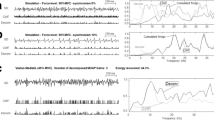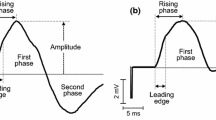Abstract
The potential fields generated by single fibres far from the sources are non-propagating. This suggests that there should be differences in the features of surface motor unit (MU) potentials (MUPs) detected from deep and superficial muscles. We explored the features using a simulation approach. We have shown that the non-propagating character and similar shapes among surface MUPs recorded over a wide area above deep muscles with monopolar or longitudinal single differential (LSD) electrodes are natural. Contrary to close distances, at large radial distances single differentiation did not emphasize MUP main phase relative weight. The position of the end plate area could be estimated with LSD detections only for MUs with long (123 mm) almost symmetric fibres. With short fibres, the LSD main phase was masked by the outlined terminal phases. This could be misleading in MUP analysis since the terminal phases reflect standing sources. The highly asymmetric fibres could yield peculiar MUP shapes resembling MUPs of two distinct MUs. We have shown that the relative weight of terminal phases at large fibre-electrode distance decreases under abnormal peripheral conditions. However, the changes in membrane depolarization due to fatigue or pathology could be assessed non-invasively also from deep muscles.





Similar content being viewed by others
References
Arabadzhiev TI (2013) Peculiarities of extracellular potentials produced by deep muscles Part 1: Single fibre potential fields. Med Biol Eng Comput. doi:10.1007/s11517-013-1037-6
Arabadzhiev TI, Dimitrov GV, Chakarov VE, Dimitrov AG, Dimitrova NA (2008) Effects of changes in intracellular action potential on potentials recorded by single-fiber, macro, and belly-tendon electrodes. Muscle Nerve 37:700–712
Arabadzhiev TI, Dimitrov GV, Dimitrova NA (2003) Simulation analysis of the ability to estimate motor unit propagation velocity non-invasively by different two-channel methods and types of multi-electrodes. J Electromyogr Kinesiol 13:403–415
Arabadzhiev TI, Dimitrov GV, Dimitrova NA (2005) Simulation analysis of the performance of a novel high sensitive spectral index for quantifying M-wave changes during fatigue. J Electromyogr Kinesiol 15:149–158
Biedermann HJ, Shanks GL, Forrest WJ, Inglis J (1991) Power spectrum analyses of electromyographic activity. Discriminators in the differential assessment of patients with chronic low-back pain. Spine (Phila Pa 1976) 16:1179–84
Dimitrov GV, Arabadzhiev TI, Mileva KN, Bowtell JL, Crichton N, Dimitrova NA (2006) Muscle fatigue during dynamic contractions assessed by new spectral indices. Med Sci Sports Exerc 38:1971–1979
Dimitrov GV, Dimitrova NA (1974) Extracellular potential field of an excitable fibre immersed in anisotropic volume conductor. Electromyogr Clin Neurophysiol 14:437–450
Dimitrov GV, Dimitrova NA (1998) Precise and fast calculation of the motor unit potentials detected by a point and rectangular plate electrode. Med Eng Phys 20:374–381
Dimitrova N (1973) Influence of the length of the depolarized zone on the extracellular potential field of a single unmyelinated nerve fibre. Electromyogr Clin Neurophysiol 13:547–558
Dimitrova N (1974) Model of the extracellular potential field of a single striated muscle fibre. Electromyogr Clin Neurophysiol 14:53–66
Dimitrova NA, Dimitrov GV (2002) Amplitude-related characteristics of motor unit and M-wave potentials during fatigue. A simulation study using literature data on intracellular potential changes found in vitro. J Electromyogr Kinesiol 12:339–349
Dimitrova NA, Dimitrov GV (2006) Electromyography (EMG) modeling. In: Metin A (eds) Wiley Encyclopedia of Biomedical Engineering, John Wiley and Sons, Inc, Hoboken
Dimitrova NA, Dimitrov GV, Nikitin OA (2002) Neither high-pass filtering nor mathematical differentiation of the EMG signals can considerably reduce cross-talk. J Electromyogr Kinesiol 12:235–246
Dimitrova NA, Hogrel JY, Arabadzhiev TI, Dimitrov GV (2005) Estimate of M-wave changes in human biceps brachii during continuous stimulation. J Electromyogr Kinesiol 15:341–348
Farina D, Gazzoni M, Merletti R (2003) Assessment of low back muscle fatigue by surface EMG signal analysis: methodological aspects. J Electromyogr Kinesiol 13:319–332
Farina D, Merletti R, Indino B, Nazzaro M, Pozzo M (2002) Surface EMG crosstalk between knee extensor muscles: experimental and model results. Muscle Nerve 26:681–695
Farina D, Mesin L, Martina S, Merletti R (2004) Comparison of spatial filter selectivity in surface myoelectric signal detection: influence of the volume conductor model. Med Biol Eng Comput 42:114–120
Gabriel DA, Kamen G, Frost G (2006) Neural adaptations to resistive exercise: mechanisms and recommendations for training practices. Sports Med 36:133–149
Grassme R, Arnold D, Anders C, van Dijk JP, Stegeman DF, Linss W, Bradl I, Schumann NP, Scholle H (2005) Improved evaluation of back muscle SEMG characteristics by modelling. Pathophysiology 12:307–312
Larivière C, Arsenault AB, Gravel D, Gagnon D, Loisel P (2002) Evaluation of measurement strategies to increase the reliability of EMG indices to assess back muscle fatigue and recovery. J Electromyogr Kinesiol 12:91–102
Merletti R, Lo Conte L, Avignone E, Guglielminotti P (1999) Modeling of surface myoelectric signals—Part I: model implementation. IEEE Trans Biomed Eng 46:810–820
Nandedkar S, Stålberg E (1983) Simulation of macro EMG motor unit potentials. Electroencephalogr Clin Neurophysiol 56:52–62
Ng JK, Richardson CA, Jull GA (1997) Electromyographic amplitude and frequency changes in the iliocostalis lumborum and multifidus muscles during a trunk holding test. Phys Ther 77:954–961
Roy SH (2003) The Use of Electromyography for the Identification of Fatigue in Lower Back Pain Motriz. Rio Claro 9:15–20
Seynnes OR, de Boer M, Narici MV (2007) Early skeletal muscle hypertrophy and architectural changes in response to high-intensity resistance training. J Appl Physiol 102:368–373
Shiraishi M, Masuda T, Sadoyama T, Okada M (1995) Innervation zones in the back muscles investigated by multichannel surface EMG. J Electromyogr Kinesiol 5:161–167
Stegeman DF, Linssen WH (1992) Muscle fiber action potential changes and surface EMG: a simulation study. J Electromyogr Kinesiol 2:130–140
Acknowledgments
This work was supported by the Bulgarian National Science Fund, grant DMU03/75. The author gratefully acknowledges Prof. Nonna Dimitrova and Prof. Roberto Merletti for their valuable comments on the manuscript.
Author information
Authors and Affiliations
Corresponding author
Rights and permissions
About this article
Cite this article
Arabadzhiev, T.I. Peculiarities of extracellular potentials produced by deep muscles. Part 2: motor unit potentials. Med Biol Eng Comput 51, 769–779 (2013). https://doi.org/10.1007/s11517-013-1043-8
Received:
Accepted:
Published:
Issue Date:
DOI: https://doi.org/10.1007/s11517-013-1043-8




